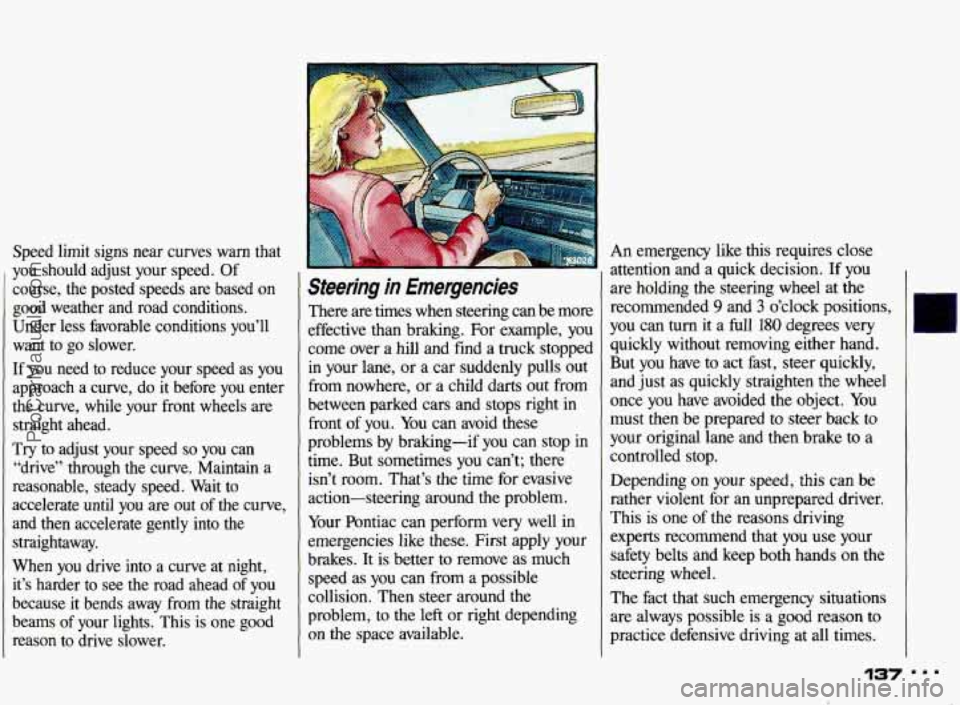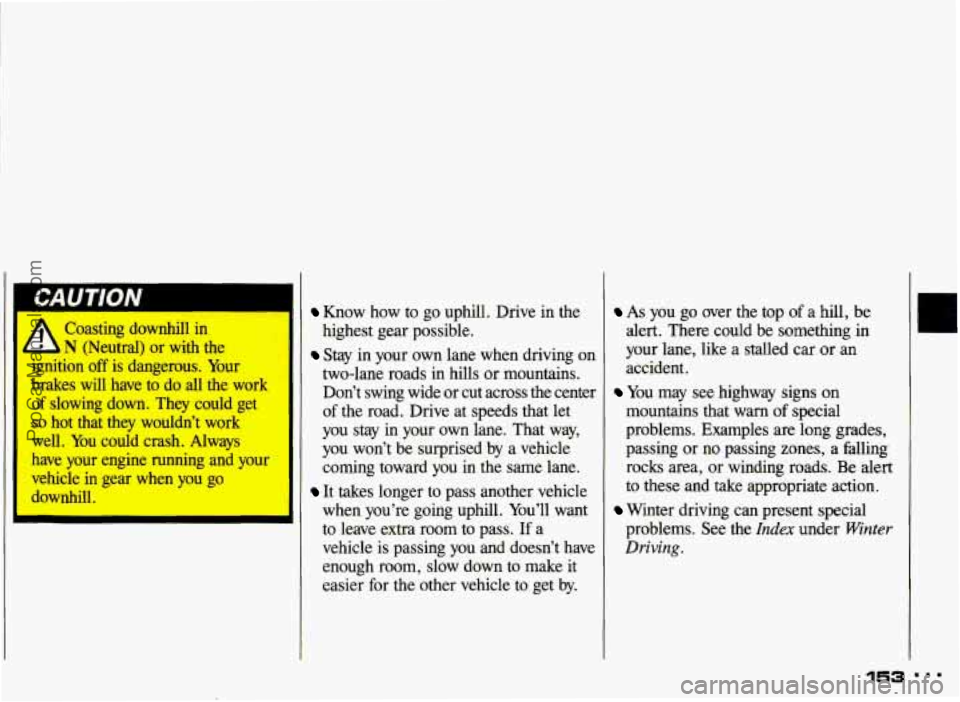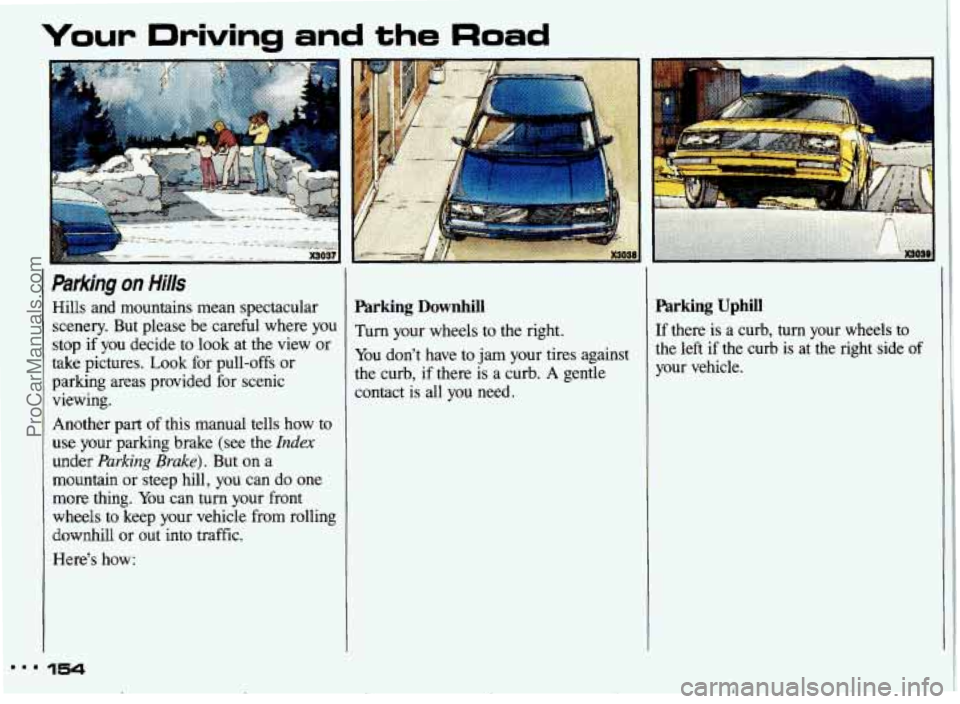1993 PONTIAC GRAND-AM brake
[x] Cancel search: brakePage 138 of 306

Speed limit signs near curves warn that
you should adjust your speed. Of
course, the posted speeds are based
on
good weather and road conditions.
Under less favorable conditions you’ll
want to go slower.
If you need to reduce your speed as you
approach a curve, do it before you enter
the curve, while your front wheels are
straight ahead.
Try to adjust your speed
so you can
“drive” through the curve. Maintain a
reasonable, steady speed. Wait to
accelerate until
you are out of the curve,
and then accelerate gently into the
straightaway.
When
you drive into a curve at night,
it’s harder to see the road ahead of you
because it bends away from the straight
beams of your lights. This is one good
reason to drive slower.
Steering in Emergencies
There are times when steering can be more
effective than braking. For example, you
come over a hill and find a truck stopped
in your lane, or a car suddenly pulls out
from nowhere, or a child darts out from
between parked cars and stops right in
front of you.
You can avoid these
problems by braking-if
you can stop in
time. But sometimes you can’t; there
isn’t
room. That’s the time for evasive
action-steering around the problem.
Your Pontiac can perform very well in
emergencies like these. First apply your
brakes. It is better to remove as much
speed as you can from a possible
collision. Then steer around the
problem, to the left or right depending
on the space available. An emergency like this requires
close
attention and
a quick decision. If you
are holding the steering wheel at the
recommended
9 and 3 o’clock positions,
you can turn it a
full 180 degrees very
quickly without removing either hand.
But
you have to act fast, steer quickly,
and just as quickly straighten the wheel
once
you have avoided the object. You
must then be prepared to steer back to
your original lane and then brake to a
controlled stop.
Depending on your speed, this can
be
rather violent for an unprepared driver.
This is one of the reasons driving
experts recommend that
you use your
safety belts and keep both hands on the
steering wheel.
The fact that such emergency situations
are always possible is a good reason to
practice defensive driving at all times.
ProCarManuals.com
Page 141 of 306

Your Driving and the Road
Passing (CONT.)
Check your mirrors, glance over your
shoulder, and
start your left lane
change signal before moving out of the
right lane to pass. When you are far
enough ahead of the passed vehicle to
see its front in your inside mirror,
activate your right lane change signal
and move back into the right lane.
(Remember that your right outside
mirror
is convex. The vehicle you just
passed may seem to be farther away
from
you than it really is.)
140
Try not to pass more than one vehicle
at a time on two-lane roads.
Reconsider before passing the next
vehicle.
vehicle too rapidly. Even though the
brake lights are not flashing, it may be
slowing down
or starting to turn.
If you’re being passed, make it easy
for the following driver to get ahead of
you. Perhaps you can ease a little to
the right.
Don’t overtake a slowly moving
Loss of Control
Let’s review what driving experts say
about what happens when the three
control systems (brakes, steering and
acceleration) don’t have enough friction
where the tires meet the road to do what
the driver has asked.
In any emergency, don’t give up. Keep
trying to steer and constantly seek an
escape route or area
of less danger.
ProCarManuals.com
Page 146 of 306

Driving too fast through Parge water
puddles or even going through some
vehicle washes can cause problems, toc The water may affect your brakes.
Try
to avoid puddles. But if you can’t, try to
slow down before you hit them.
t.
I
1 CAUTION I
Wet brakes can cause
accidents. They won’t work
dl in a quick stop and may cause
pulling to one side. You could lose
control of the vehicle.
After driving through a large
puddle of water or a vehicle wash,
apply your brake pedal lightly until
your brakes work normally.
Hydroplaning
Hydroplaning is dangerous. So much
water can build up under your tires that
they can actually ride on the water. This
can happen if the road is wet enough
and you’re going fast enough. When
your vehicle is hydroplaning, it has little
or no contact with the road.
You might not be aware
of hydroplaning.
You could drive along for some time
without realizing your tires aren’t in
constant contact with the road. You
could find out the hard way: when you
have to slow, turn, move out to pass-or
if you get hit by a gust
of wind. You could
suddenly find yourself out of control. Hydroplaning doesn’t
happen often. But
it can if your tires haven’t much tread
or
if the pressure in one or more is low. It
can happen if a lot of water is standing
on the road. If you can
see reflections
from trees, telephone poles, or other
vehicles, and raindrops “dimple” the
water’s surface, there could
be
hydroplaning.
Hydroplaning usually happens at higher
speeds. There just isn’t
a hard and fast
rule about hydroplaning. The best
advice is to slow down when it
is
raining, and be careful.
145 ’
ProCarManuals.com
Page 150 of 306

Driving on the Freeway
Once you are on the freeway, adjust
your speed to the posted
limit or to the
prevailing rate if it’s slower. Stay in the
right lane unless
you want to pass. If
you are on a two-lane freeway, treat the
right lane as the slow lane and the left
lane as the passing lane.
If you are on a three-lane freeway, treat
the right lane as the slower-speed
through lane, the middle lane as the
higher-speed through lane, and the left lane as the passing lane.
Before changing lanes, check your rearview mirrors. Then use your
turn
signal. Just before you leave the lane,
glance quickly over your shoulder to
make sure there isn’t another vehicle in
your “blind” spot. If you
are moving from an outside to a
center lane on a freeway having more
than two lanes, make sure another
vehicle isn’t about to move into the same
spot. Look at the vehicles two lanes
over and watch for telltale signs: turn
signals flashing, an increase in speed, or
moving toward the edge
of the lane. Be
prepared to delay your move.
Once you are moving on the freeway,
make certain you allow a reasonable
following distance. Expect to move
slightly slower at night.
leaving the Freeway
When you want to leave the freeway,
move to the proper lane well
in advance.
Dashing across lanes at the last minute
is dangerous. If you miss your exit do
not, under any circumstances, stop and
back up. Drive on to the next exit.
At each exit point is a deceleration lane.
Ideally it should be long enough for you
to enter it at freeway speed (after
signaling,
of course) and then do your
braking before moving onto the exit
ramp. Unfortunately, not
all deceleration
lanes are long enough-some are too
short for all the braking. Decide when
to start braking.
If you must brake on
the through lane, and if there is traffic
close behind you, you can allow a little
ProCarManuals.com
Page 151 of 306

Your Driving and the Road
Leaving the Freeway (CONT.)
extra time and flash your brake lights (in
addition to your turn signal) as extra
warning that you are about to slow
down and exit.
The exit ramp can be curved, sometimes
quite sharply. The exit speed is usually
posted. Reduce your speed according to
your speedometer, not to your sense of
motion. After driving for any distance at
higher speeds, you may tend to think
you are going slower than you actually
are. For example,
40 mph (65 km/h)
might seem like only
20 mph (32 km/h).
Obviously, this could lead to serious
trouble
on a ramp designed for 20 mph
(32 km/h)!
150
Driving a Long Distance
Although most long trips today are
made on freeways, there are still many
made on regular highways.
Long-distance driving on freeways and
regular highways is the same in some
ways. The trip has to be planned and the
vehicle prepared, you drive at higher-
than-city speeds, and there are longer
turns behind the wheel. You’ll enjoy
your trip more if you and your vehicle
are in good shape. Here are some tips
for a successful long trip.
Before Leaving on a Long nip
Make sure you’re ready. Try to be well
rested.
If you must start when you’re not
fresh-such as after a
day’s work-don’t
plan to make too many miles that first
part of the journey. Wear comfortable
clothing and shoes you can easily drive
in.
Is your vehicle ready for a long trip? If
you keep it serviced and maintained, it’s
ready to go. If it needs service, have it
done before starting out. Of course,
you’ll find experienced and able service
experts in Pontiac dealerships all across
North America. They’ll be ready and willing to help if you need it.
ProCarManuals.com
Page 153 of 306

your urwlng and the Road
Highway Hypnosis (CONI)
Keep your eyes moving. Scan the road
ahead and to the sides. Check your
rearview mirrors frequently and your
instruments from time to time. This
can help you avoid a fixed stare.
Wear good sunglasses in bright light.
Glare can cause drowsiness. But don’t
wear sunglasses at night. They will
drastically reduce your overall vision
at the very time you need all the
seeing power you have.
If you get sleepy, pull off the road into
a rest, service, or parking area and
take a nap, get some exercise, or both.
For safety, treat drowsiness on the
highway as an emergency.
As in any driving situation, keep pace
with traffic and allow adequate
following distances.
I CAUTION
d
Hill and Mountain Roads
Driving on steep hills or mountains is
different from driving in flat or rolling
terrain. If
you drive regularly in steep
country, or
if you’re planning to visit
there, here are
some tips that can make
your trips safer and more enjoyable.
Keep your vehicle in good shape.
Check all fluid levels and also the
brakes, tires, cooling system and
transaxle. These parts can work hard
on mountain roads.
Know how to go down hills. The most
important thing to know
is this: let
your engine do some of the slowing
down. Don’t make your brakes
do it
all. Shift to a lower gear when
you go
down a steep or long hill. That way,
you will slow down without excessive
use of your brakes.
A
If you don’t shift down, your
brakes could get
so hot that
they wouldn’t work well.
You
would then have poor braking or
even none going down a hill. You
could crash. Shift down to let your
engine assist your brakes on
a
steep downhill slope.
ProCarManuals.com
Page 154 of 306

CAUTION
A
Coasting downhill in
N (Neutral) or with the
ignition
off is dangerous. Your
brakes will have to do all the work
of slowing down. They could get
so hot that they wouldn’t work
well. You could crash. Always
have your engine running and your
vehicle in gear when you go
downhill.
Know how to go uphill. Drive in the
highest gear possible.
Stay in your own lane when driving on
two-lane roads in hills or mountains.
Don’t swing wide or cut across the center
of the road. Drive at speeds that let
you stay in your own lane. That way,
you won’t be surprised by a vehicle
coming toward you
in the same lane.
It takes longer to pass another vehicle
when you’re going uphill. You’ll want
to leave extra room to pass. If a
vehicle
is passing you and doesn’t have
enough room, slow down to make it
easier- for the other vehicle to get by.
As you go over the top of a hill, be
alert. There could be something in
your lane, like a stalled
car or an
accident.
You may see highway signs on
mountains that warn of special
problems. Examples are long grades,
passing or no passing zones, a falling
rocks area, or winding roads.
Be alert
to these and take appropriate action.
problems. See the
Index under Winter
Driving.
Winter driving can present special
153
ProCarManuals.com
Page 155 of 306

Your Driving and the Road
parking on Hills
Hills and mountains mean spectacular
scenery. But please be careful where you
stop if you decide to look at the view or
take pictures. Look for pull-offs or
parking areas provided for scenic
viewing.
Another part
of this manual tells how to
use your parking brake (see the
Index
under Parking Brake). But on a
mountain or steep hill, you can do one
more thing. You can turn your front
wheels to keep your vehicle from rolling
downhill or out into traffic.
Here's how:
Parking Downhill
Turn your wheels to the right.
You don't have to jam your tires against
the curb, if there is
a curb. A gentle
contact is all you need.
Parking Uphill
If there is a curb, turn your wheels to
the left if the curb is at the right side of
your vehicle.
ProCarManuals.com